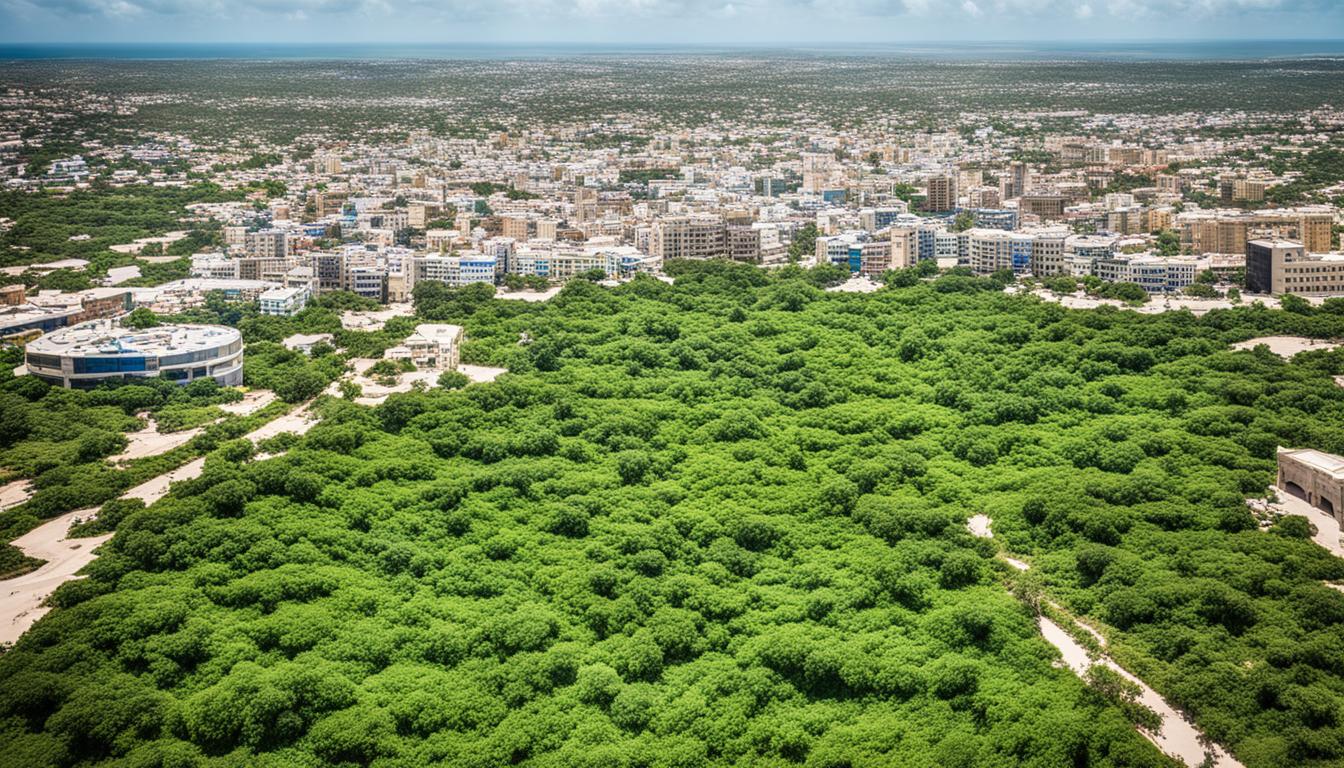China Sacred Natural Sites and Biodiversity
Did you know that sacred natural sites (SNS) are recognized as the oldest form of habitat protection in human history? These remarkable areas have a profound impact on biodiversity conservation across continents, with a particular focus on Asia and Africa. In China, sacred natural sites play a vital role in preserving the country’s rich biodiversity.
Key Takeaways:
- China’s sacred natural sites are crucial for biodiversity conservation.
- Sacred lands in China serve as biodiversity hotspots and provide habitats for protected wildlife.
- Indigenous communities in China have developed traditional practices for SNS conservation.
- SNS have positive effects on taxonomical diversity, vegetation structure, and cultural uses of biodiversity.
- More research is needed to address geographical and taxonomical biases in SNS conservation.
The Importance of SNS in Biodiversity Conservation
Sacred lands in China are of utmost importance for the conservation of biodiversity. These extraordinary sites serve as biodiversity hotspots, providing crucial habitats for a diverse range of protected wildlife species. Through their preservation, sacred lands contribute immensely to the conservation efforts aimed at safeguarding China’s remarkable natural heritage.
China’s sacred lands are invaluable reservoirs of biodiversity. They boast a rich diversity of flora and fauna, representing unique ecosystems that support a myriad of species. These biodiverse hotspots serve as vital refuges for endangered and endemic species, contributing significantly to the preservation of China’s native wildlife.
“The conservation of sacred lands in China is of paramount importance in protecting the country’s biodiversity. These sites are invaluable repositories of life, providing sanctuary for numerous wildlife species and safeguarding the delicate ecological balance.”
The significance of these sacred lands goes beyond their conservation value. They are deeply intertwined with the cultural fabric of China, holding spiritual and religious significance for many communities. The reverence and respect accorded to these sites by the local population further contribute to their protection and conservation.
The Role of Protected Wildlife in China
Protected wildlife in China represents a diverse array of species, ranging from majestic big cats like the Amur leopard to iconic animals such as the giant panda. These protected wildlife species find sanctuary within the sacred lands of China, where they are shielded from various threats and can thrive in their natural habitats.
The conservation efforts focused on protecting these valuable wildlife populations are multifaceted. They involve strict wildlife protection laws, habitat restoration initiatives, and community-based conservation efforts. The sacred lands play a fundamental role in these comprehensive strategies, acting as havens for the preservation of China’s enchanting and vulnerable wildlife.
The Economic and Ecological Importance of Biodiversity Hotspots
Biodiversity hotspots in China possess not only ecological value but also significant economic importance. These areas attract eco-tourism, offering nature enthusiasts a chance to experience the wonders of China’s unique ecosystems and encounter its exceptional wildlife.
Furthermore, biodiversity hotspots contribute to ecosystem services, providing benefits such as clean air and water, soil fertility, and climate regulation. The preservation of these hotspots, including the sacred lands within them, is crucial for maintaining the ecological balance and ensuring the sustainable development of the region.
| Benefits of Sacred Lands in China | Biodiversity Conservation | Cultural Significance | Economic Value |
|---|---|---|---|
| Protection of endangered species | Preservation of unique ecosystems | Intertwined with local traditions and beliefs | Contribution to eco-tourism |
| Habitat maintenance for endemic species | Support for ecosystem services | Guardians of cultural heritage | Economic benefits from nature-based tourism |
Traditional Practices in SNS Conservation
Indigenous communities in China have rich and diverse traditional practices that contribute to the conservation of Sacred Natural Sites (SNS). These practices are based on centuries of traditional ecological knowledge, passed down through generations, and play a vital role in ensuring the sustainable management of these sacred sites.
Traditional practices in SNS conservation encompass a range of rituals, taboos, and community-based approaches. These practices are deeply rooted in the cultural and spiritual beliefs of indigenous communities, forming an integral part of their cultural heritage.
“Our traditional practices are not just about preserving the physical landscape of the sacred sites, but also about respecting the spiritual connection we have with nature. It is about maintaining a harmonious relationship with our natural surroundings.” – Li Ming, a member of the Miao indigenous community in China.
Rituals play a significant role in SNS conservation, as they are believed to maintain the balance and harmony between humans and nature. These rituals include ceremonies, festivals, and offerings, which are performed at specific times of the year to honor the sacredness of the site and show gratitude to the land and its resources.
Taboos are another essential aspect of traditional practices in SNS conservation. These sacred rules and restrictions guide behavior within the sacred sites, ensuring sustainable resource use and preventing actions that may harm the ecological balance. Taboos are often grounded in local ecological knowledge and blend practical conservation principles with cultural and spiritual values.
Promoting Community-Based Conservation
Community-based conservation approaches are characteristic of traditional practices in SNS conservation. These approaches involve active participation and decision-making by the local indigenous communities, empowering them as stewards of the land. By involving the communities in the conservation process, their traditional knowledge and practices are both respected and preserved, fostering a sense of ownership and responsibility towards the sacred sites.
Community-based conservation approaches promote local capacity building, ensuring that the knowledge and skills necessary for the long-term management and monitoring of the SNS are passed down to future generations. These approaches also promote social cohesion and enhance the resilience of indigenous communities, strengthening their cultural identity and connection to the land.

The traditional practices in SNS conservation are a testament to the wisdom and intricate understanding of nature held by indigenous communities in China. They offer valuable insights into sustainable land management practices and highlight the importance of preserving and incorporating traditional ecological knowledge into mainstream conservation efforts.
Next, we will explore the positive effects of SNS on biodiversity, shedding light on the taxonomical diversity and vegetation structure fostered by these sacred sites.
Positive Effects of SNS on Biodiversity
Studies have shown that Sacred Natural Sites (SNS) have a significant positive impact on biodiversity. These sacred sites contribute to increased taxonomical diversity, improved vegetation structure, and the preservation of cultural uses of biodiversity.
One of the key benefits of SNS is their role as refugia for threatened species. These sites provide a safe haven for endangered plants and animals, allowing them to thrive and reproduce. By offering protection from human activities and habitat degradation, SNS help safeguard the survival of these vulnerable species.
SNS also play a crucial role in maintaining a balanced ecology. The vegetation structure within these sites offers a diverse range of microhabitats, supporting a wide array of species. This contributes to the overall taxonomical diversity, ensuring a healthy and resilient ecosystem.
Furthermore, the cultural uses of biodiversity are preserved within SNS. These sacred sites are often imbued with cultural significance and are used for traditional practices, such as medicinal plant harvesting, spiritual rituals, and community gatherings. By protecting these sites, not only are biodiversity and ecosystem services preserved, but cultural heritage and traditions are also safeguarded.
The Role of SNS in Biodiversity Conservation
“Sacred natural sites have been shown to have positive effects on taxonomical diversity, vegetation structure, and cultural uses of biodiversity. They act as refugia for threatened species, protect old-growth trees, and maintain ecological balance in surrounding areas.”
Research has demonstrated that the positive effects of SNS on biodiversity extend beyond individual sites. The ecological benefits of these sacred areas spill over into the surrounding landscape, contributing to the overall conservation efforts in the region.
By acknowledging and leveraging the positive impact of SNS on biodiversity, conservationists and policymakers can integrate these sacred sites into broader conservation frameworks. This recognition will aid in their governance and management, ensuring their long-term protection and sustainability.

| Positive Effects of SNS on Biodiversity | Description |
|---|---|
| Taxonomical Diversity | SNS contribute to increased taxonomical diversity by providing habitats for a wide range of species, supporting ecosystem resilience. |
| Vegetation Structure | The unique vegetation structure within SNS creates diverse microhabitats, benefiting a variety of plants and animals. |
| Cultural Uses of Biodiversity | SNS preserve traditional practices and cultural uses of biodiversity, ensuring the continuity of ancient knowledge and rituals. |
In conclusion, the positive effects of SNS on biodiversity are evident through increased taxonomical diversity, improved vegetation structure, and the preservation of cultural uses of biodiversity. These sacred sites act as refugia for threatened species, protect old-growth trees, and maintain ecological balance in the surrounding areas. By recognizing the importance of SNS and integrating them into conservation frameworks, we can ensure the continued preservation of biodiversity and cultural heritage.
Geographical and Taxonomical Biases in SNS Research
While the study of Sacred Natural Sites (SNS) has provided valuable insights into biodiversity conservation, it is important to acknowledge the existence of geographical and taxonomical biases in the research conducted thus far. Most studies on SNS have predominantly focused on Asia and Africa, resulting in geographical biases that limit our understanding of SNS in other regions. Additionally, there is a noticeable taxonomical bias in SNS research, with studies primarily focusing on plants, leaving other taxonomic groups underrepresented.
To gain a comprehensive understanding of the effects of SNS on biodiversity, it is crucial to address these biases by conducting research in other regions and exploring different taxonomic groups. By expanding the scope of SNS research, we can gain a more holistic perspective on the benefits and challenges associated with these sacred sites and their role in biodiversity conservation.
The Geographical Bias in SNS Research
The geographical bias in SNS research is largely attributed to the concentration of studies in Asia and Africa, where a significant number of culturally and ecologically significant SNS are located. While these regions contribute valuable insights, it is essential to explore SNS in other parts of the world to understand the broader implications of their conservation. By examining SNS in diverse geographical contexts, we can better appreciate the unique challenges and opportunities they present for biodiversity conservation.
The Taxonomical Bias in SNS Research
The taxonomical bias in SNS research is evident in the disproportionate focus on plant species within the field. While plant biodiversity is undoubtedly important, it is equally crucial to study the effects of SNS on other taxonomic groups such as animals, fungi, and microorganisms. Addressing this bias allows for a more comprehensive understanding of the ecological dynamics and interactions within SNS and their impact on overall biodiversity.
To overcome these biases, future SNS research should aim to broaden its geographical scope and include a wider range of taxonomic groups. This inclusive approach will help uncover valuable insights into the role of SNS in biodiversity conservation, enabling the development of effective conservation strategies that account for the diverse ecological contexts in which these sacred sites are found.
The Role of SNS in OECMs
Sacred Natural Sites (SNS) play a vital role in biodiversity conservation and can be considered as Other Effective Area-Based Conservation Measures (OECMs). These sites provide complementary conservation measures to Protected Areas (PA) and contribute to overall conservation efforts.
Integration of SNS into official conservation frameworks is essential to ensure their proper governance and management. By recognizing the value of SNS as OECMs, conservation efforts can be expanded beyond traditional protected areas, maximizing the preservation and sustainable management of ecosystems.
| Benefits of Integrating SNS into OECMs |
|---|
| 1. Enhanced Biodiversity Conservation |
| 2. Increased Connectivity between Protected Areas |
| 3. Preservation of Cultural and Spiritual Heritage |
Integrating SNS into OECMs promotes enhanced biodiversity conservation by expanding the geographic coverage of conservation efforts and protecting habitats beyond traditional protected areas. This allows for the preservation of species and ecosystems that may not be adequately represented within PAs.
Furthermore, the inclusion of SNS in OECMs contributes to increased connectivity between protected areas. By recognizing the ecological significance of SNS and establishing linkages between different conservation areas, the movement and migration of species across landscapes can be facilitated, ensuring the long-term viability of populations.
“The integration of SNS into OECMs not only strengthens biodiversity conservation but also preserves cultural and spiritual heritage. SNS hold immense cultural, historical, and spiritual value for communities, making their recognition and protection crucial for the continuity of traditional practices and the safeguarding of cultural diversity.”
Recognizing SNS as OECMs requires collaboration among local communities, governments, and conservation organizations. This enables the establishment of effective governance mechanisms and management strategies that respect cultural traditions while ensuring the ecological integrity of these sacred sites.

Challenges and Future Research in SNS Conservation
Despite the benefits of Sacred Natural Sites (SNS) for biodiversity conservation, there are several challenges that need to be addressed in their conservation. These challenges arise due to conflicts between traditional practices and modern development, lack of recognition in conservation policies, and gaps in geographical and taxonomical research.
One of the major challenges in SNS conservation is the conflict between traditional practices and modern development. As societies evolve, traditional practices may clash with the demands of urbanization, industrialization, and economic growth. Striking a balance between preserving sacred lands and catering to the needs of a growing population is essential.
Another challenge is the lack of recognition of SNS in conservation policies. While SNS have demonstrated their positive impact on biodiversity, they often receive less attention compared to other conservation areas such as national parks and wildlife reserves. This lack of recognition limits the resources and support available for their conservation.
Gaps in geographical and taxonomical research present another challenge in SNS conservation. Most research has focused on Asia and Africa, resulting in geographical biases. Additionally, there has been a taxonomical bias towards studying plants rather than other species. To fully understand the impact and potential of SNS for biodiversity conservation, further research is needed in different regions and on diverse taxonomic groups.
To overcome these challenges and enhance SNS conservation, future research should focus on filling these gaps and advancing knowledge in this field. Research efforts need to expand beyond geographical and taxonomical biases to encompass a broader range of sacred sites and species. This will provide a more comprehensive understanding of the benefits and potential threats to SNS.
Furthermore, interdisciplinary research that integrates cultural, social, and ecological perspectives is crucial for effective SNS conservation. By involving local communities, indigenous knowledge, and traditional practices, conservation strategies can be tailored to specific contexts, ensuring the long-term preservation of SNS and their associated biodiversity.
Challenges in SNS Conservation
| Challenges | Implications |
|---|---|
| Conflicts between traditional practices and modern development | Threatens the preservation of sacred lands |
| Lack of recognition in conservation policies | Limited resources and support for conservation efforts |
| Gaps in geographical and taxonomical research | Restricted understanding of the full impact of SNS on biodiversity |
By addressing these challenges and prioritizing future research on SNS conservation, we can ensure the continued protection and conservation of these sacred sites. This will not only benefit biodiversity but also contribute to the preservation of cultural heritage and traditional knowledge.

Overall, recognizing the challenges and investing in future research is essential for the effective conservation of Sacred Natural Sites. By doing so, we can maximize the potential of these sites for biodiversity preservation and the sustainable development of our natural landscapes.
Local Ecological Knowledge in SNS Conservation
Local communities hold a wealth of ecological knowledge that can greatly contribute to the conservation of Sacred Natural Sites (SNS). Their traditional knowledge and practices play a vital role in the sustainable management and monitoring of these sacred sites. By integrating local ecological knowledge into conservation strategies, we can enhance the effectiveness of SNS conservation.
Preserving Traditional Knowledge for Conservation
Local communities have inherited generations’ worth of traditional knowledge about the natural world. This knowledge encompasses the relationships between different species, the seasonal patterns of flora and fauna, and sustainable land management practices. By actively involving community members in conservation efforts and valuing their traditional knowledge, we can tap into a valuable resource for the protection and restoration of SNS.
“The present generation is fortunate to inherit the wisdom of our ancestors, who have passed down their knowledge of the land and its creatures. It is our responsibility to ensure that this traditional knowledge is preserved and integrated into conservation strategies.” – Li Mei, a community elder in Yunnan province.
Community-Based Conservation Approaches
A key aspect of local ecological knowledge is its emphasis on community-based conservation approaches. Local communities have developed sustainable practices that take into account the interconnectedness of ecosystems and the long-term well-being of both human communities and the natural environment. These approaches often include participatory decision-making processes, ensuring that the voices and perspectives of local communities are respected and integrated into conservation initiatives.
The Value of Oral Traditions and Local Wisdom
Oral traditions play a vital role in the transmission of local ecological knowledge. Through stories, songs, and proverbs, elders pass down valuable information about the natural world, ecological processes, and the cultural significance of SNS. These oral traditions help forge a deep connection between people and their environment, reaffirming the importance of conservation efforts in maintaining the delicate balance between human communities and nature.
| Benefits of Local Ecological Knowledge in SNS Conservation |
|---|
| 1. Enhanced understanding of local ecosystems and species interactions |
| 2. Identification of effective conservation practices tailored to specific environments |
| 3. Promotion of sustainable land management techniques to preserve biodiversity |
| 4. Strengthened community engagement and ownership in conservation initiatives |
Image: Local communities contribute their ecological knowledge to SNS conservation.

Tibetan Sacred Sites in China
Tibetan sacred sites hold immense cultural and ecological significance in China’s sacred natural sites. These sacred sites, scattered across the Tibetan region, have been preserved and managed through traditional land management systems that have contributed to the conservation of biodiversity.
Participatory mapping and documentation efforts have played a crucial role in understanding the distribution, size, and management practices associated with these sacred sites. Through these efforts, researchers and local communities have gained valuable insights into the ecological importance of Tibetan sacred sites and their contribution to biodiversity conservation.
Traditional land management practices in Tibetan sacred sites involve a deep understanding of the local ecosystem and the establishment of sustainable practices that respect the sacredness of the sites. These practices include limitations on resource extraction, grazing restrictions, and the implementation of community-based conservation approaches.
The integration of traditional knowledge and modern scientific research has provided a comprehensive understanding of the ecological and cultural significance of Tibetan sacred sites. This holistic approach ensures the preservation of biodiversity, while also respecting the spiritual and cultural values associated with these sacred lands.
The conservation of Tibetan sacred sites not only protects the fragile ecosystems of the Tibetan region but also contributes to the overall biodiversity of China. These sites serve as refugia for a wide range of plant and animal species, including endangered and endemic species.

Cultural Heritage and Biodiversity
“Tibetan sacred sites are not just places of religious significance; they are also essential for the conservation of biodiversity. The traditional land management practices associated with these sites have allowed for the coexistence of humans and nature for centuries.”
– Dr. Tenzin Wangyal, Ecologist
The connection between cultural heritage and biodiversity conservation is a fundamental aspect of Tibetan sacred sites. These sites serve as living examples of the harmonious relationship between humans and their natural environment, providing valuable lessons in sustainable land management.
By recognizing and supporting the traditional land management systems in Tibetan sacred sites, China can ensure the long-term preservation of these invaluable sites and their significant contribution to biodiversity conservation.
| Benefits of Tibetan Sacred Sites | Examples |
|---|---|
| Preservation of threatened species | Snow leopard, Himalayan blue sheep, Tibetan antelope |
| Conservation of endemic plant species | Rhododendron (Rhododendron spp.), Tibetan gentian (Gentiana tibetica), Tibetan primrose (Primula tibetica) |
| Maintenance of critical habitats | Alpine meadows, high-altitude lakes, and sacred forests |
| Protection of water resources | Glacial meltwater, source of major rivers in Asia |
The Role of Traditional Beliefs in Biodiversity Conservation
Traditional beliefs of indigenous communities play a critical role in biodiversity conservation. One such community is the Baima Tibetans, whose ancient religious beliefs and traditional knowledge have contributed significantly to the preservation of local biodiversity in China.
The Baima Tibetans, who inhabit the highlands of the Tibetan Plateau, have a deep respect for nature and a strong connection to their ancestral lands. Their traditional beliefs and practices revolve around the idea of living in harmony with the natural world, recognizing the interdependence between humans and the environment.
These traditional beliefs guide their actions and decisions, shaping their attitude towards nature and biodiversity. For example, the Baima Tibetans consider the giant panda as a sacred animal, believing it to be a reincarnation of a deity. This belief has played a crucial role in the conservation of the giant panda population, as it has led to the protection of their habitats and a ban on hunting.
“We believe that by protecting the giant panda and its habitat, we are protecting the balance of nature and ensuring our own well-being,” says Tsering Wangmo, a Baima Tibetan elder.
In addition to their religious beliefs, the Baima Tibetans also possess a wealth of traditional ecological knowledge. This knowledge has been passed down from generation to generation, encompassing practices such as sustainable land management, rotational grazing, and medicinal plant use. By incorporating this traditional knowledge into their conservation efforts, the Baima Tibetans have been able to safeguard their unique biodiversity and maintain the ecological integrity of their ancestral lands.
Recognizing the value of traditional beliefs and practices in biodiversity conservation is vital for the sustainable management of ecosystems. By integrating indigenous knowledge systems into conservation strategies, we can create a more holistic approach that respects both cultural diversity and environmental preservation.
Preserving Traditional Knowledge
Preserving traditional knowledge is crucial for the continued success of biodiversity conservation. Efforts should be made to document and protect the traditional beliefs and practices of indigenous communities like the Baima Tibetans. This can be achieved through the establishment of cultural and ecological conservation centers, where traditional knowledge holders can pass on their wisdom to future generations.
Furthermore, collaboration between indigenous communities and scientific researchers can lead to mutually beneficial partnerships. Scientists can learn from the traditional knowledge and practices of indigenous communities, while indigenous communities can benefit from the scientific expertise and resources available.
Conclusion
In conclusion, China’s sacred natural sites play a vital role in biodiversity conservation. These sites have a positive impact on taxonomical diversity, vegetation structure, and cultural uses of biodiversity. They serve as important refugia for threatened species and contribute to the preservation of China’s natural heritage.
However, it is crucial to address the geographical and taxonomical biases in research on sacred natural sites. Further studies should focus on other regions and different taxonomic groups to gain a comprehensive understanding of their conservation value. Additionally, challenges like conflicts between traditional practices and modern development, as well as the lack of recognition in conservation policies, need to be addressed to ensure effective preservation.
Integrating local ecological knowledge and traditional practices into conservation strategies can enhance the effectiveness of sacred natural sites conservation in China. By recognizing and incorporating these valuable resources, we can ensure the long-term sustainability of these sites and the biodiversity they harbor.








